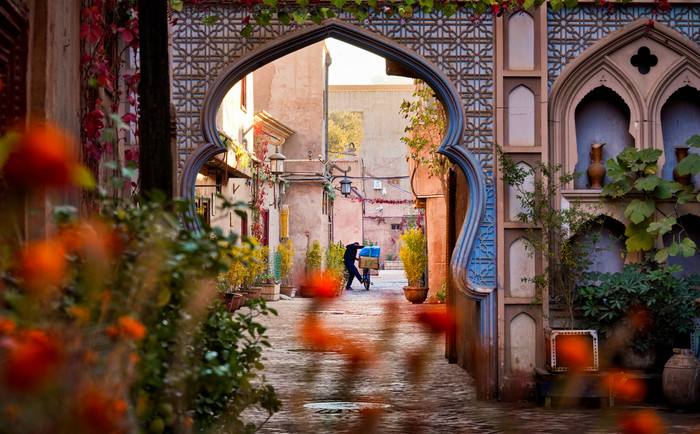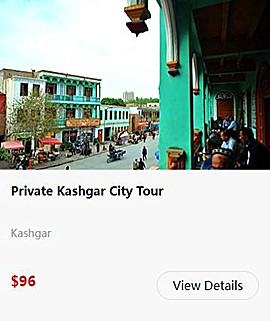When you stand in the Old Town, it is like standing in the boundless ancient oil painting, you may think that this is the charm of the Silk Road.
Kashgar was a stop on the ancient Silk Road, and prosperous east-west trade created this ancient city. As China’s westernmost city, it has a history of thousands of years that can be traced back to the influence of Central Asia. It’s impossible to explore the city in a single day because there are so many famous places to visit.
Kashgar is a bustling city and a place where cultures meet.  The city center of Kashgar covers an area of 4.25 square kilometers and has about 126,800 residents. In the center of Kashgar, there is an old town- Kashgar Old Town, which has a history of more than 2,000 years and is like a vivid scroll of Xinjiang Uighur folk custom. The Old Town is crisscrossed with streets and lanes, with flexible layout and winding paths. Most of the residential buildings are civil, brick and wood structures. Many of the traditional residential buildings have a history of hundreds of years, making it the only labyrinth urban block featured by Islamic culture in China.
The city center of Kashgar covers an area of 4.25 square kilometers and has about 126,800 residents. In the center of Kashgar, there is an old town- Kashgar Old Town, which has a history of more than 2,000 years and is like a vivid scroll of Xinjiang Uighur folk custom. The Old Town is crisscrossed with streets and lanes, with flexible layout and winding paths. Most of the residential buildings are civil, brick and wood structures. Many of the traditional residential buildings have a history of hundreds of years, making it the only labyrinth urban block featured by Islamic culture in China.
The residential buildings in the core area of the Old Town are one of the largest indigenous buildings in the world. The indigenous buildings themselves are of great historical significance and value, integrating the Han and Tang dynasties, ancient Roman traditions and the characteristics of modern life of the Uighur nation.
What to visit in Old Town
On the loess high cliffs at the southeastern end of the Old Town, there is a group of Uighur residents. The houses here are built along the cliff and are built on the basis of civil engineering. Between these arbitrarily constructed upstairs and outer buildings, there are more than 50 alleys extending in all directions, crisscrossing, winding, up and down. Walking into the alley, you can see "cross-street buildings" or "half-street buildings" everywhere, and pedestrians walk past these buildings.This is rare in other places. This kind of "cross-street building" makes full use of the space, solves the shortage of land, and does not affect the living or use of people who live here. Although these houses are built of mud, they are very strong, and many of them can even survive hundreds or even tens of millions of years.
Walking in the khaki-yellow alleys of the residents of Gaotai, you can see the gates of the residential courtyards built along the alleys open against the walls, and one house is next to the other, which is very comfortable. Push open the door and walk into the courtyard, you will find another world - green plants, colorful yurts, and gorgeous floral fabrics, which make your vision a huge shift. Each courtyard has its own characteristics, some are slightly larger, some are slightly smaller, no matter which courtyard you go to, you will see all kinds of trees and flowers planted in the courtyard. Mulberry trees, figs, pomegranates, grapes, and roses etc., which are loved by the Uighur people, create an elegant living environment for the host and embellish the life here.
other, which is very comfortable. Push open the door and walk into the courtyard, you will find another world - green plants, colorful yurts, and gorgeous floral fabrics, which make your vision a huge shift. Each courtyard has its own characteristics, some are slightly larger, some are slightly smaller, no matter which courtyard you go to, you will see all kinds of trees and flowers planted in the courtyard. Mulberry trees, figs, pomegranates, grapes, and roses etc., which are loved by the Uighur people, create an elegant living environment for the host and embellish the life here.
Walking in the ancient and clean alleys, time seems to go back to the century of the ancient city of Jiaohe and the ancient city of Gaochang. The alleys are rugged and winding, and the earth walls are simple and vast. What is rare is that although it is an open tourist destination, the life of the residents in the community has not been affected. Go down the stairs to the courtyard to see the clean small courtyard. There are grapes, figs and other flowers and plants in the courtyard. When you walk into the resident’s hut, it is very gorgeous and warm. Various ethnic costumes dress up the whole house with colorful and ethnic characteristics. The floors of these houses are covered with thick carpets, and a long table in the center of the house is placed with various dried fruits and other delicious foods.
These unplanned and arbitrarily built upstairs and outside buildings are arranged in deep, extending, winding alleys of Kashgar Gaotai residents, which have now become a business card of Kashgar. In 2009, the Chinese government invested billions to start the renovation project of the Old Town of Kashgar, enhancing the building’s earthquake resistance and renovating the streets, while preserving the style and charm of traditional Uighur architecture. The reconstructed Old Town of Kashgar has become a 5A-level tourist attraction. Mornings in the ancient city are very lively, with many tourists flocking to the tea room to enjoy the view of buildings and alleys while sipping traditional Uighur herbal tea. Besides the tea room, the alleys are also crowded with various pavilions where you can find local handicrafts such as jade, musical instruments and bronze teapots. Here gathers the world’s largest civil construction complex. Narrow labyrinthine alleys, beautifully carved doors and windows, and quaint dwellings give you a glimpse into the former glory of the bustling old town, whose exotic charm attracts tourists from all over the country and abroad.
streets, while preserving the style and charm of traditional Uighur architecture. The reconstructed Old Town of Kashgar has become a 5A-level tourist attraction. Mornings in the ancient city are very lively, with many tourists flocking to the tea room to enjoy the view of buildings and alleys while sipping traditional Uighur herbal tea. Besides the tea room, the alleys are also crowded with various pavilions where you can find local handicrafts such as jade, musical instruments and bronze teapots. Here gathers the world’s largest civil construction complex. Narrow labyrinthine alleys, beautifully carved doors and windows, and quaint dwellings give you a glimpse into the former glory of the bustling old town, whose exotic charm attracts tourists from all over the country and abroad.
What’s more, Kashgar Old Town is the shooting location of The Kite Runner, and it is also the place where the Uighur folk customs are concentrated. It is like walking into a time tunnel to explore the mysterious history of the ancient Western Regions; and you will have a special time here.
Seeing is believing.
How to get to the Old Town
1. Travelers can take the bus No.2,7,8, 22, 28 to the Idger station, which is run through the Old Town.
2. Travelers can take the bus No.7,15 get off at the East Gate station, enter through east gate and see the Open Ceremony.( Open Ceremony start at 10:30am, 12:00am, 18:00pm)
3. Travelers can also take taxi to Old Town,the starting price of taxi in Kashgar City is 8 CNY.
4. It takes about 20 mins (12 km ) to drive from Kashgar Airport to Old Town.
5. It takes about 15 mins (9 km ) to drive from Kashgar station to Old Town.
Most Popular Route to Kashgar







































